In this issue
- No More Australian Troops to Afghanistan
- Very Significant community response to IPAN Newspaper Advertisement
- GDAMS Day (Global Day of Action against Military Spending)
- The On-going Disaster of Australia’s Policy in Afghanistan – James O’Neill
- Quakers in Action outside U.S. Military Base
- Keep Australia out of U.S. Wars – Nick Deane
- Examining the strings attached to a U.S. friendship – Peter Barrack
- The Greens call for an Independent Australian Foreign Policy
- Date Claimer: IPAN National Conference- Melbourne 8,9,10 September, 2017
- National Day of Action: BAN THE BOMB
- How U.S. Military Bases back dictators….. by David Vines
- What the Nth Korean “Crisis” is really about by Paul Craig Roberts
- Environmental impact of Talisman Sabre
- IPAN State activities coming up
27th May, 2017
NO MORE AUSTRALIAN TROOPS TO AFGHANISTAN
IPAN (Independent and Peaceful Australia Network) calls on PM Malcolm Turnbull and Defence Minister Marise Payne to resist the call by U.S. President Trump for Australia to commit more troops to the U.S. war in Afghanistan. This call by IPAN is backed by thousands of Australians from all walks of life including the 4,000 who recently signed the public call statement: “Keep Australia out of U.S.Wars”
[box] KEEP AUSTRALIA OUT OF U.S.WARSVery significant community response to IPAN’s Newspaper advertisement[/box]
The statement was published on the weekend of 6-7 May in the national newspaper The Saturday Paper to coincide with the highly-publicised meeting in the U.S. on 5 May, between President Trump and the Australian Prime Minister, Malcolm Turnbull. The advertisement statement as it appears has 360 signatures on page 6 of the Saturday Paper, as shown below
The statement has been signed to date by close to 3,600 individuals and organisations from around Australia, including health workers, lawyers, academics, teachers, unions and unionists, current and former politicians, community and faith organisations. The complete list of signatures to the statement can be viewed on IPAN’s website www.ipan.org.au
GDAMS Day
(Global Action against Military Spending)
Public actions in WA (top photos) and ACT lower photos
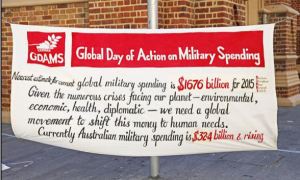

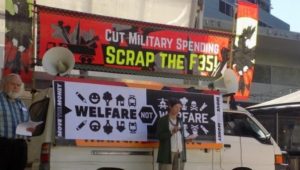
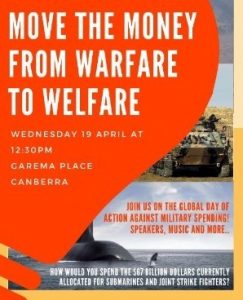
The On-going Disaster of Australia’s Policy in Afghanistan
by James O’Neill
According to a recent news report Australia is “open” to a request from the United States for more troops to be sent to Afghanistan. According to the report, Australian troops “mostly work in a training and support role aimed at strengthening the Afghan force’s ability to protect their own country. “ “It is important, said Prime Minister Malcolm Turnbull, “that we work together to build up the capacity of Afghanistan’s own security forces so that they can keep that country secure from the threat of terrorism.” (1)
There was no opposition to this suggestion from Labor leader Bill Shorten, and neither did the country’s media outlets bother to consider either the inherent absurdity of the Prime Minister’s statement, or consider the geopolitical context that prevails in Afghanistan.
This has been the pattern ever since Afghanistan was invaded and occupied by a US led coalition, including Australia, ostensibly in response to the events of 11 September 2001 in the United States. That terrorist event was immediately attributed to al Qaeda, led by Osama bin Laden, who was being sheltered by the Taliban government of Afghanistan, who in turn refused to hand bin Laden over to the Americans. (2)
That this sequence of events is almost entirely fictional has never been allowed to disturb the official narrative, which is regularly brought out to justify maintaining, or as with the most recent request, increasing troop numbers. Quite what improvements in the situation in Afghanistan this latest ‘mini-surge’ might achieve is not clear. (3)
One might have thought that after more than fifteen years of occupation, with the Taliban occupying more of the country than at any time since 2001, some fresh insights might be more productive. Similarly, when there has already been an expenditure of more than one trillion US dollars with no noticeable improvements and a great deal of deterioration in the country’s infrastructure, a better use of taxpayer’s dollars might be found. (4)
There are other measurements of the occupation’s “success”. For example, opium production is now more than 20 times higher than it was in 2001. Or, as the UN pointed out recently, more than 9.3 million people, or 26% of the country’s population are in need of urgent humanitarian assistance. (5) At the very least one might expect that this dismal record would induce a fundamental reappraisal of existing policy.
That has not happened and is unlikely to happen because it is abundantly clear that the US government and its coalition allies are unable or unwilling to look clearly at the historical reality. Without the willingness or ability to face reality, a fact based policy formulation is that much harder. The historical realities are well known and equally well documented, although the mainstream media seem incapable of acknowledging them. Ignoring reality is hardly a rational basis for policy. Among the matters that are not allowed to intrude upon the official discourse include, in far from exhaustive examples:
- Al Qaeda was formed in Pakistan in the late 1970s for the purpose of overthrowing the then relatively secular and Soviet supported government of Afghanistan. (6)
- The American trained and Saudi financed terrorists, then known as Mujihideen, were part of Operation Cyclone. Afghanistan was not the only target. The Muslim dominated republics of the southern USSR and China’s Xinjiang province were, and are, targets of terrorist infiltration and disruption. (7)
- The decision to invade Afghanistan was made in July 2001, months before the terrorist attacks of 9/11, when the Taliban government refused to allow an American consortium to build and control a gas pipeline from the Caspian Basin through Afghanistan, and instead gave the contract to an Argentinian company, Bridas. (8)
- The Taliban government had virtually eliminated opium production, at least in the areas that it controlled. One of the first consequences of the western invasion and occupation was a rapid and sustained increase in opium production. Afghanistan now accounts for more than 90% of the world’s heroin with a street value of between $150 and $200 billion depending on the level of purity. (9)
- Then, as now, the narcotics trade is a vital part of CIA funding, as well as serving geopolitical goals such as causing destabilization in the target countries. It kills, for example, 25,000 Russians each year. (10)
Despite the expenditure of more than $1 trillion since 2001, there is no national rail system, not one new major hospital, and Afghan life expectancy is the 15th lowest in the world. The Afghan security forces, allegedly being trained ‘to build up their capacity to secure the country from terrorism’ contains significant “ghost forces”, i.e. non-existent security forces, the wages for whom disappear into the corrupt pockets of local officials. (11)
In the now familiar refrain, the utter failure of western policy in Afghanistan is blamed on others. According to US Brigadier-General Cleveland in 2016, “Russia and Iran were undermining the US and NATO.” (12)
What Russia has actually been doing, in co-operation with other States in close proximity to Afghanistan and adversely affected by the chaos continually generated there, is to try and create the conditions for a peaceful resolution of the conflict. A peaceful resolution would of course eliminate the US-NATO-Australia justification for remaining.
Although not reported in the Australian media, Afghan officials have approached Russia asking for help. (13) The vehicle for that assistance is likely to be the Collective Security Treaty Organisation (CSTO) with which Afghanistan has observer status. The CSTO is in turn linked to the Shanghai Cooperation Organisation ({SCO) which Afghanistan will be linked to through China’s massive One Belt One Road (OBOR) program.
Afghanistan’s significant reserves of rare earth minerals, essential in modern technology, give it the potential to be a major contributor to OBOR’s infrastructure projects. OBOR, not least though the growing geostrategic partnership between Russia and China, represents a major challenge to the US’s unipolar hegemonic view of the world. The US will accordingly do nothing to promote the success of OBOR. On the contrary, its support for terrorist activities in countries participating in OBOR is aimed in part at inhibiting China and Russia from being countervailing forces to the US.
On 18 February 2017 a conference was held in Moscow to discuss Afghanistan’s security future. China, India, Iran, Pakistan and Afghanistan were the other attendees. A further conference, also in Moscow, was held on 14 April 2017, with 11 nations from the region participating. (14)
The US was invited, but refused to attend. Australia was not invited, most probably because, as with the Astana peace conference on Syria, Australia is seen as an appendage of the US with no useful independent contribution to make.
If the US led coalition was really interested in a resolution of the ongoing Afghanistan security problems they would have welcomed the opportunity the Moscow conferences represented to break what US General John Nicholson, the US Commander in Afghanistan accurately described as a “stalemate.” (15)
Instead, we have the US military asking, yet again, for a boost in troop numbers, and Australia almost certainly to acquiesce, thus extending its participation in a useless war that does nothing to promote Australia’s true national security interests.
A well-known definition of insanity holds that one is insane if one repeats the same action over and over and expects a different result. Australia’s policy is not only dishonest and based on historical falsehoods and avoidance of reality, it is also arguably insane.
*Barrister at Law and geopolitical analyst. He may be contacted at joneill@qldbar.asn.au
References
- abc.com.au 12 May 2017
- David Ray Griffin The New Pearl Harbor Revisited. Olive Branch Press 2012
- Sjursen The Hazards of Military Worship www.TomDispatch.com 11 May 2017
- Cloughley Surging Corruption in Afghanistan www.counterpunch.org 12 May 2017
- UN Office for Coordination of Humanitarian Assistance “Humanitarian Needs Overview” UN New York 2017.
- Brzezinski The Grand Chessboard Basic Books 1998
- Coll Ghost Wars Penguin 2004
- Chin Unocal and the Afghanistan Pipeline www.onlinejournal.com 6 & 10 March 2002
- Chossudovsky The Spoils of War: Afghanistan’s Multibillion Dollar Heroin Trade www.globalresearch.ca 1 April 2017
- Korzun US Rejects Russia’s Invitation to Take Part in Conference on Afghanistan www.strategicculture.org 1 April 2017.
- Becevich The Never Ending War in Afghanistan www.nytimes.com 13 March 2017.
- Black A Russian Peace Plan for an American War. www.journal-neo.org 10 April 2017.
- Korzun op cit.
- ibid.
- Gorka NATO to Boost Military Presence in Afghanistan: Mission Impossible. www.strategicculture.org 12 May 2017
Quakers in Action outside US Pine Gap Military Base.
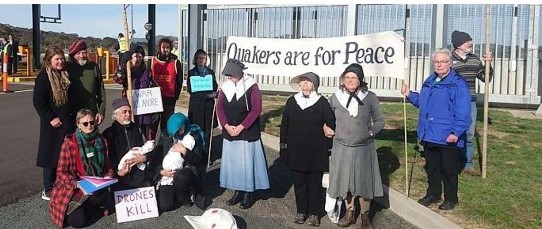
NICK DEANE. Keep Australia out of US wars
Posted on 12 May 2017 by John Menadue “Pearls and Irritations”
In the event of war between the USA and any other nation in our region, Australia could not avoid involvement, because of its alliance with the USA. That is the reality we need to address. To avoid the possibility of war, an independent foreign policy for Australia is urgently required. Mr Trump’s presidency only adds to the urgency.
Since President Trump’s inauguration, there has been a noticeable spike in commentary about the increasing risk of a war in our region – a war that could involve the USA and China or North Korea. As things stand, it would be impossible for Australia to avoid involvement in such a war. That is a reality that we must urgently confront.
In our region we can see concern over North Korea’s growing military might (and corresponding antagonism from the USA, South Korea and Japan); tension between Japan and China over the Daioyu/Senkaku Islands in the East China Sea, and tension in the South China Sea, the major trade-route where China is constructing facilities on reclaimed islands. The background to all these points of tension is the USA’s ‘pivot’ to the Asia-Pacific, which involves a substantial build-up of US military assets in the region.
What is actually going on amounts to a regional arms-race. Think-tanks and academics now openly discuss the possibility of war between China and the USA. Checking the map shows that US military facilities form a chain that almost encircles China.
How does this affect Australia?
The answer is simple and was expressed very clearly by late ex-PM Malcolm Fraser in his book ‘Dangerous Allies’. The fact is that there are US assets on Australian soil that are of such military significance that, in the event of hostilities, no enemy of the USA could afford to leave them untouched.
For example, Pine Gap plays a crucial role in US surveillance and communication. It would be a prime target for attack. Secondly, the US Marine Air-Ground Task Force (MAGTF), stationed in Darwin, is designed to project US power. Furthermore, under the buzz-word ‘interoperability’, Australia’s defence forces are ever more closely integrated into the military forces of the US. An Australian warship is part of the US Seventh Fleet and an Australian general is deputy commander of the US Army in the Pacific. Australian and US forces conduct massive, biannual joint military exercises (Exercise Talisman Sabre, due to start again this July). Much of the weaponry used by our forces originates in the US (the prime example being the F35 Joint Strike Fighter). Our ADF’s internal communications make use of American-controlled systems – meaning that the US could, if it found it advantageous, shut them down. It is arguable that Australia cannot now conduct its own military operations unless the US approves of them.
No wonder that Barack Obama, who visited Australia in 2011 to announce the MAGTF, said, when addressing Australian troops, “You can’t tell where our guys end and you guys begin…” This blurred line between American and Australian military forces means that any potential enemy of America is also, automatically, the potential enemy of Australia. The same blurred line extends to Australia’s foreign policy – witness the manner in which Australia has boycotted UN discussions on a treaty to ban nuclear weapons. Our nation has a misguided obsession with the US alliance. The unfortunate consequence is that we are, by default, gaining enemies where we need have none.
To summarise, Australia’s so-called defence is largely determined by the interests of the USA. The perversely named ‘Australian Defence Force’ (ADF) has not been deployed to defend Australia in the more than 70 years since WWII. Yet in the same period it has been engaged in numerous hostile actions in countries distant from our own, that posed us no threat – in every case alongside US forces (think Korea, Vietnam, Afghanistan, Iraq and Syria.)
From this perspective, Australia has given away its independence and compromised its defence. In what is coming to be known as ‘Fraser’s paradox’, we think we can rely on the USA to ‘protect’ us, when the only reason we need that protection is because we host such important US military assets. The ‘protector’ is the reason we need ‘protection’. This bears a striking resemblance to a protection racket.
There is not much that is new in the foregoing argument. However, the emergence of an unpredictable president of the US, Donald Trump, has raised the stakes. The recent missile attack on a Syrian military airfield (surely an act of war) and the movement of a US battle fleet to South Korean waters give the situation heightened urgency.
What is to be done?
A radical re-assessment of Australia’s defence and foreign policies is necessary. Continuing on the present path is leading the nation into very dangerous waters.
As a step in this direction, the Independent and Peaceful Australia Network (IPAN*) has issued a statement entitled ‘Keep Australia out of US Wars’, which was published on May 6. It states
”We believe Australia’s military alliance with the US, involving the complicity of successive Australian governments in US global military agendas, undermines Australia’s peace security and sovereignty.”
The statement demands less spending on all things military and the diversion of public funds to socially beneficial activities. It argues that the people must take control of foreign policy and review the presence of US forces.
The statement was published with the names of 350 concerned individuals and organisations, who supported it and contributed to the expense of placing an advertisement in a national newspaper. These included three Senators; 3 Sydney Peace Prize winners; the Medical Association for the Prevention of War (MAPW); the MUA, and numerous prominent academics and legal figures. The total number of people expressing support (including via Facebook) has now reached over 3,500.
The full text, and facility for indicating support and making a donation, can be found on IPAN’s website https://ipan.org.au/#/ , under ‘Statements’.
For the present, war in our region is just a possibility. As events unfold, though, that possibility appears to be growing. However far off war might be, now is the time to speak out about it and stop its’ approach. One way to do that is offered by adding your name to the list of those who support IPAN’s statement.
*IPAN is an expanding national network composed of diverse community groups – all of which support the causes of peace and independence for Australia. IPAN came
Article in Newcastle Herald
Examining the strings attached to a U.S. friendship
by Peter Barrack
(Peter Barrack, OAM, was secretary of Newcastle Trades Hall Council for 21 years)
With the election of Donald Trump as U.S. President the world has been thrown into distraction, despite an interview with China’s President, Xi Jinping, there has been no evidence of withdrawal of Americas threat to go to war with China.
So what is the basis of American objective, it is simply the rise of China and the decline of the U.S. in their respective global trade growths. America has publicly declared it will not allow this to happen.
The fact that China is a huge creditor and the U.S. is such a huge debtor is founded on its addiction to spend and import. At the end of Obama’s terms the U.S. debt was $19.9 trillion, (unfortunately $5 trillion of this belonged to China on loan).
It is incredulous that China is so surreptitiously charged as the aggressor when it is simply engaging in a strategy of protection, when it has been globally known that the U.S. has a plan to engage China in war. It is a plan that has been manifested in the U.S. over a period of 15 years.
When President Obama first came to power he announced a withdrawal of troops from Iraq, (Bush’s debacle), and imposed a pre-planned “pivot” to South East Asia, which was two thirds of U.S. Forces would be transferred to South East Asia and the Pacific. In the current period more than 400 military bases encircle China with missiles, bombers, warships and nuclear weapons.
In a close range circle of China, including within the Sea of Japan, east China sea and South China sea, China is confronted with entrapment by U.S. Military bases (with all the above equipment), in Japan (7), South Korea (2), Philippines (4), Brunei (1), Singapore (1), Guam (1), and now Australia (3), given by the servile generosity of former P.M., Julia Gillard, they are troops (Northern Territory), bombers (Darwin), and battle ships (Perth), the objective to fulfil the transit is by 2020.
Amilai Etziani, Professor of International Affairs at George Washington University predicts, quote, “the U.S. is preparing for a war with China, a momentous decision, that has so far failed to receive a thorough view from elected officials, namely Congress. This war would begin with a blinding attack against anti-access facilities, including, land and sea based missile launches, satellite and anti-satellite weapons” further,
The incalculable risk that, “deep inland attacks could be mistakenly perceived by the Chinese as a pre-emptive attempt to take out its nuclear weapons, thus cornering them into a terrible, “use- it -or-loose-it” dilemma that could lead to a nuclear war.”
A cynical act of historical overthrows of countries by U.S.A.has threatened American status. Released by D.F.A.T. in late 215, it says that our total exports to China that year were $76 billion, $50 billion of those exports were iron ore, coal, copper and gold, which posses a question, quote,”why would China want to destroy the continuity of that process when trade would be going to China”.
Four Australian Prime Ministers (2 A.L.P. and 2 Liberal), have since 2006 called for Australia to terminate the servitude to the U.S. And become a country of self interest and decision making. Three of the four were, the late Gough Whitlam, the late Malcolm Frazer and Paul Keating, the fourth at the time was not a Prime Minister but he was a member of Parliament (Malcolm Turnbull), it was during the time of the President Obamas visit when he said, “an Australian Government needs to be careful not to allow a doe eyed fascination with the leader of the U.S. To distract from reality that our national interest requires us truly (not just rhetorically) to maintain both an ally in Washington and a good friend in Beijing”.
It is time for Australia to follow Malcolm Turnbulls suggestion, i.e. it is time to ascent to our own democracy and if necessary have the U.S. as a friend.
Our decision covers the following:- do we continue superfluous unnecessary wars or the continued growth and trade of peace.
The decision is for ours to debate and decide, NOW.
The Greens National Conference calls for an Independent Australian Foreign Policy
At the 2017 National Conference in Alice Springs, the Australian Greens reconfirmed their opposition to the role of the Pine Gap spy base in nuclear weapons targeting, illegal drone strikes and indiscriminate data collection on millions of people around the region. We support an independent foreign policy based on equality, human security and the rule of law. We call for the urgent renegotiation of the defence and foreign policy relationship with the United States which has seen Australia play a subservient and deeply counterproductive role in global affairs for many decades.
Accepted by consensus

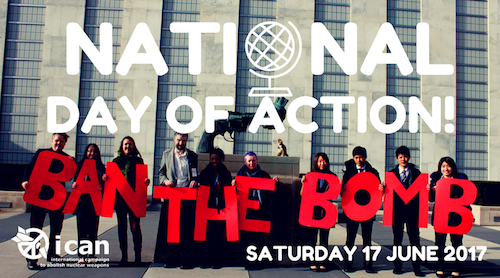
UN negotiations to ban and eliminate nuclear weapons will resume in less than a month, with the draft treaty text to be released this coming Monday by the Chair of the conference, Costa Rican Ambassador Elayne Whyte.
Saturday 17th June will see a mass mobilisation in New York City, the Women’s March to Ban the Bomb. In Australia we’re responding with a National Day of Action, including events in seven cities!
Saturday 17 June is a key moment to demonstrate public support for a treaty banning nuclear weapons, and outrage at our Government’s refusal to engage. It’s up to us to demand Australia sign the impending treaty banning nuclear weapons, just as it has done for chemical and biological weapons, cluster munitions and anti-personnel landmines.
At this time of heightened nuclear tensions, meaningful action for disarmament is more important than ever.
The details for all events in Australia are available here. To be clear; many of the events are led by women, but inclusive of all!
Please help us make June 17 a huge success by promoting the events through your networks, write to your local paper about it, put posters up, paint banners and bring all your friends along!
If there is nothing planned for your area, why not organise something?
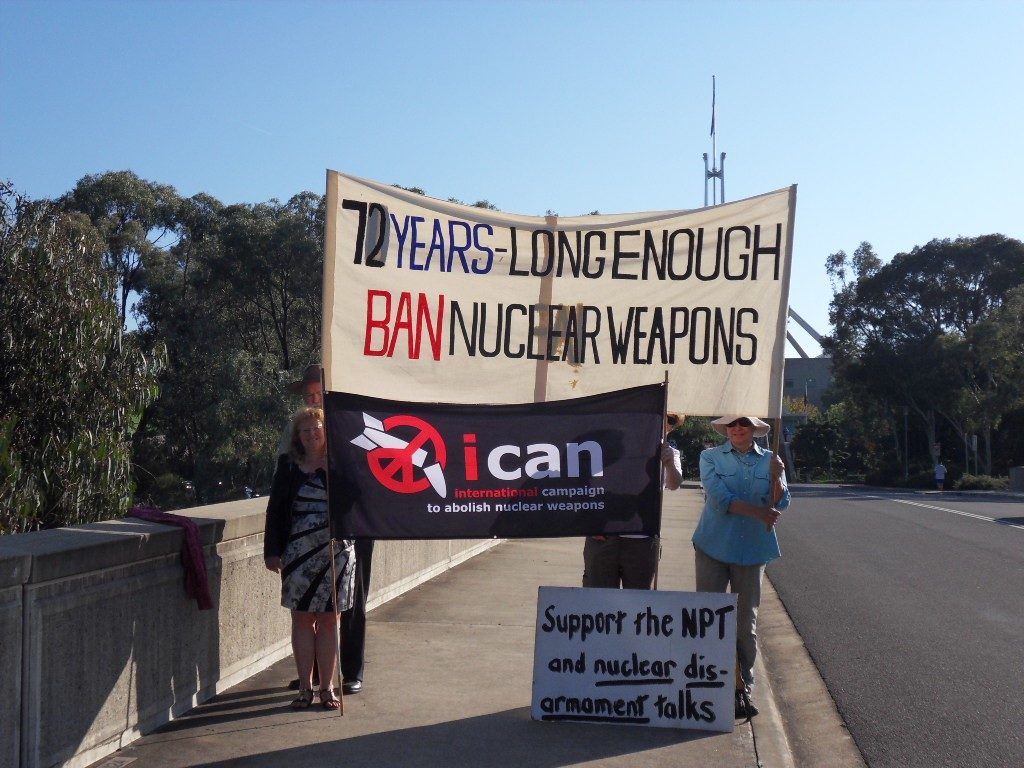
CANBERRA
Rally to Ban the Bomb… finally!
Saturday 17th June from 12-1pm
Garema Place, Canberra
Speakers: Alex White, Unions ACT | Barbara O’Dwyer, WILPF | Angela Chen Chen and Byron Knight, ANU students | George Browning, former Anglican Bishop for Canberra and Goulburn | Sue Wareham, ICAN
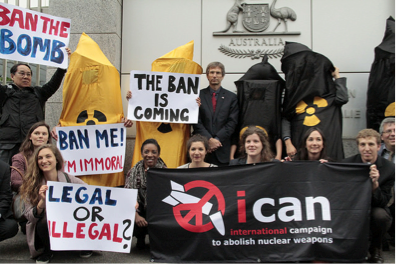 BRISBANE
BRISBANE
Global Women’s March to Ban the Bomb!
Saturday 17th June from 12-3pm
Queens Park, Brisbane City
This action is led by WILPF, Just Peace, Friends of the Earth and Believing Women for a Culture of Peace. Speakers & performers TBA.
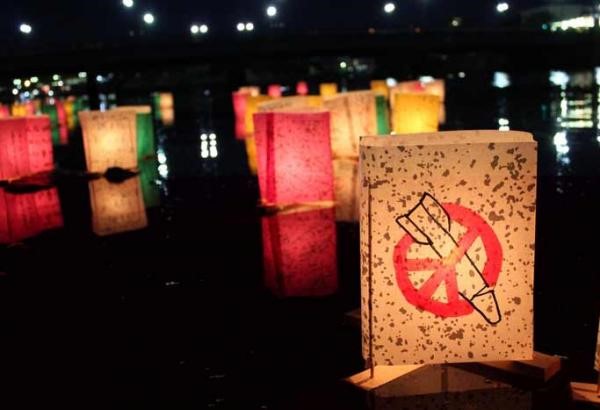 HOBART
HOBART
Women Ban the Bomb Vigil
Saturday 17th June from 12-1pm
Parliament House Gardens, 11 Morrison St, Hobart.
A one-hour vigil. Bring your banners, families and friends to show our government you want an end to the threat of nuclear war
 MELBOURNE
MELBOURNE
Women’s March to Ban the Bomb
Saturday 17th June 1-3pm
State Library, Melbourne
Join us for a rally and march against Australia’s boycott of historic UN negotiations to outlaw nuclear weapons. Speakers: Jenny Grounds, MAPW | Sue Coleman-Haseldine, Kokatha | more TBA
SYDNEY
Women’s March to Ban the Bomb
Saturday 17th June from 12-3pm
Defence Minister Marise Payne’s office at 2-12 Macquarie St, Parramatta
Speakers: Dr Helen Caldicott | Rosemary Lester, Yankunytjatjara-Anangu | Margot Pearson, WILPF | Asian Women at Work Drumming Group, more TBA.
PERTH
Tour of US bases
Friday 16th – Sunday 18th June
Join a whirlwind road trip touring the US bases around Perth and camping in state forests. Contact: mia.peppper@ccwa.org.au
DARWIN
Saturday 17th June
Organising is underway. To get involved or find out more, contact Justin at justin@darwin.email
How U.S. Military Bases Back Dictators, Autocrats, and Military Regimes
By David Vine
May 17, 2017 “Information Clearing House” – Much outrage has been expressed in recent weeks over President Donald Trump’s invitation for a White House visit to Rodrigo Duterte, president of the Philippines, whose “war on drugs” has led to thousands of extrajudicial killings. Criticism of Trump was especially intense given his similarly warm public support for other authoritarian rulers like Egypt’s Abdel Fatah al-Sisi (who visited the Oval Office to much praise only weeks earlier), Turkey’s Recep Tayyip ).invitation, granting him increasingly unchecked powers), and Thailand’s Prayuth Chan-ocha (who also received a White House victory from President Trump on his recent referendum phone call Erdogan (who got a congratulatory
But here’s the strange thing: the critics generally ignored the far more substantial and long-standing bipartisan support U.S. presidents have offered these and dozens of other repressive regimes over the decades. After all, such autocratic countries share one striking thing in common. They are among at least 45 less-than-democratic nations and territories that today host scores of U.S. military bases, from ones the size of not-so-small American towns to tiny outposts. Together, these bases are homes to tens of thousands of U.S. troops.
“This pattern of daily support for dictatorship and repression around the world should be a national scandal in a country supposedly committed to democracy.”
To ensure basing access from Central America to Africa, Asia to the Middle East, U.S. officials have repeatedly collaborated with fiercely anti-democratic regimes and militaries implicated in torture, murder, the suppression of democratic rights, the systematic oppression of women and minorities, and numerous other human rights abuses. Forget the recent White House invitations and Trump’s public compliments. For nearly three quarters of a century, the United States has invested tens of billions of dollars in maintaining bases and troops in such repressive states. From Harry Truman and Dwight D. Eisenhower to George W. Bush and Barack Obama, Republican and Democratic administrations alike have, since World War II, regularly shown a preference for maintaining bases in undemocratic and often despotic states, including Spain under Generalissimo Francisco Franco, South Korea under Park Chung-hee, Bahrain under King Hamad bin Isa al-Khalifa, and Djibouti under four-term President Ismail Omar Guelleh, to name just four.
Many of the 45 present-day undemocratic U.S. base hosts qualify as fully “authoritarian regimes,” according to the Economist Democracy Index. In such cases, American installations and the troops stationed on them are effectively helping block the spread of democracy in countries like Cameroon, Chad, Ethiopia, Jordan, Kuwait, Niger, Oman, Qatar, Saudi Arabia, and the United Arab Emirates.
This pattern of daily support for dictatorship and repression around the world should be a national scandal in a country supposedly committed to democracy. It should trouble Americans ranging from religious conservatives and libertarians to leftists — anyone, in fact, who believes in the democratic principles enshrined in the Constitution and the Declaration of Independence. After all, one of the long-articulated justifications for maintaining military bases abroad has been that the U.S. military’s presence protects and spreads democracy.
Far from bringing democracy to these lands, however, such bases tend to provide legitimacy for and prop up undemocratic regimes of all sorts, while often interfering with genuine efforts to encourage political and democratic reform. The silencing of the critics of human rights abuses in base hosts like Bahrain, which has violently cracked down on pro-democracy demonstrators since 2011, has left the United States complicit in these states’ crimes.
During the Cold War, bases in undemocratic countries were often justified as the unfortunate but necessary consequence of confronting the “communist menace” of the Soviet Union. But here’s the curious thing: in the quarter century since the Cold War ended with that empire’s implosion, few of those bases have closed. Today, while a White House visit from an autocrat may generate indignation, the presence of such installations in countries run by repressive or military rulers receives little notice at all.
Befriending Dictators
The 45 nations and territories with little or no democratic rule represent more than half of the roughly 80 countries now hosting U.S. bases (who often lack the power to ask their “guests” to leave). They are part of a historically unprecedented global network of military installations the United States has built or occupied since World War II.
Today, while there are no foreign bases in the United States, there are around 800 U.S. bases in foreign countries. That number was recently even higher, but it still almost certainly represents a record for any nation or empire in history. More than 70 years after World War II and 64 years after the Korean War, there are, according to the Pentagon, 181 U.S. “base sites” in Germany, 122 in Japan, and 83 in South Korea. Hundreds more dot the planet from Aruba to Australia, Belgium to Bulgaria, Colombia to Qatar. Hundreds of thousands of U.S. troops, civilians, and family members occupy these installations. By my conservative estimate, to maintain such a level of bases and troops abroad, U.S. taxpayers spend at least $150 billion annually — more than the budget of any government agency except the Pentagon itself.
For decades, leaders in Washington have insisted that bases abroad spread our values and democracy — and that may have been true to some extent in occupied Germany, Japan, and Italy after World War II. However, as base expert Catherine Lutz suggests, the subsequent historical record shows that “gaining and maintaining access for U.S. bases has often involved close collaboration with despotic governments.”
The bases in the countries whose leaders President Trump has recently lauded illustrate the broader pattern. The United States has maintained military facilities in the Philippines almost continuously since seizing that archipelago from Spain in 1898. It only granted the colony independence in 1946, conditioned on the local government’s agreement that the U.S. would retain access to more than a dozen installations there.
After independence, a succession of U.S. administrations supported two decades of Ferdinand Marcos’s autocratic rule, ensuring the continued use of Clark Air Base and Subic Bay Naval Base, two of the largest U.S. bases abroad. After the Filipino people finally ousted Marcos in 1986 and then made the U.S. military leave in 1991, the Pentagon quietly returned in 1996. With the help of a “visiting forces agreement” and a growing stream of military exercises and training programs, it began to set up surreptitious, small-scale bases once more. A desire to solidify this renewed base presence, while also checking Chinese influence, undoubtedly drove Trump’s recent White House invitation to Duterte. It came despite the Filipino president’s record of joking about rape, swearing he would be “happy to slaughter” millions of drug addicts just as “Hitler massacred [six] million Jews,” and bragging, “I don’t care about human rights.”
In Turkey, President Erdogan’s increasingly autocratic rule is only the latest episode in a pattern of military coups and undemocratic regimes interrupting periods of democracy. U.S. bases have, however, been a constant presence in the country since 1943. They repeatedly caused controversy and sparked protest — first throughout the 1960s and 1970s, before the Bush administration’s 2003 invasion of Iraq, and more recently after U.S. forces began using them to launch attacks in Syria.
Although Egypt has a relatively small U.S. base presence, its military has enjoyed deep and lucrative ties with the U.S. military since the signing of the Camp David Accords with Israel in 1979. After a 2013 military coup ousted a democratically elected Muslim Brotherhood government, the Obama administration took months to withhold some forms of military and economic aid, despite more than 1,300 killings by security forces and the arrest of more than 3,500 members of the Brotherhood. According to Human Rights Watch, “Little was said about ongoing abuses,” which have continued to this day.
In Thailand, the U.S. has maintained deep connections with the Thai military, which has carried out 12 coups since 1932. Both countries have been able to deny that they have a basing relationship of any sort, thanks to a rental agreement between a private contractor and U.S. forces at Thailand’s Utapao Naval Air Base. “Because of [contractor] Delta Golf Global,” writes journalist Robert Kaplan, “the U.S. military was here, but it was not here. After all, the Thais did no business with the U.S. Air Force. They dealt only with a private contractor.”
Elsewhere, the record is similar. In monarchical Bahrain, which has had a U.S. military presence since 1949 and now hosts the Navy’s 5th Fleet, the Obama administration offered only the most tepid criticism of the government despite an ongoing, often violent crackdown on pro-democracy protesters. According to Human Rights Watch and others (including an independent commission of inquiry appointed by the Bahraini king, Hamad bin Isa al-Khalifa), the government has been responsible for widespread abuses including the arbitrary arrest of protesters, ill treatment during detention, torture-related deaths, and growing restrictions on freedoms of speech, association, and assembly. The Trump administration has already signaled its desire to protect the military-to-military ties of the two countries by approving a sale of F-16 fighters to Bahrain without demanding improvements in its human rights record.
And that’s typical of what base expert Chalmers Johnson once called the American “baseworld.” Research by political scientist Kent Calder confirms what’s come to be known as the “dictatorship hypothesis”: “The United States tends to support dictators [and other undemocratic regimes] in nations where it enjoys basing facilities.” Another large-scale study similarly shows that autocratic states have been “consistently attractive” as base sites. “Due to the unpredictability of elections,” it added bluntly, democratic states prove “less attractive in terms [of] sustainability and duration.”
Even within what are technically U.S. borders, democratic rule has regularly proved “less attractive” than preserving colonialism into the twenty-first century. The presence of scores of bases in Puerto Rico and the Pacific island of Guam has been a major motivation for keeping these and other U.S. “territories” — American Samoa, the Northern Mariana Islands, and the U.S. Virgin Islands — in varying degrees of colonial subordination. Conveniently for military leaders, they have neither full independence nor the full democratic rights that would come with incorporation into the U.S. as states, including voting representation in Congress and the presidential vote. Installations in at least five of Europe’s remaining colonies have proven equally attractive, as has the base that U.S. troops have forcibly occupied in Guantánamo Bay, Cuba, since shortly after the Spanish-American War of 1898.
Backing Dictators
Authoritarian rulers tend to be well aware of the desire of U.S. officials to maintain the status quo when it comes to bases. As a result, they often capitalize on a base presence to extract benefits or help ensure their own political survival.
The Philippines’ Marcos, former South Korean dictator Syngman Rhee, and more recently Djibouti’s Ismail Omar Guelleh have been typical in the way they used bases to extract economic assistance from Washington, which they then lavished on political allies to shore up their power. Others have relied on such bases to bolster their international prestige and legitimacy or to justify violence against domestic political opponents. After the 1980 Kwangju massacre in which the South Korean government killed hundreds, if not thousands, of pro-democracy demonstrators, strongman General Chun Doo-hwan explicitly cited the presence of U.S. bases and troops to suggest that his actions enjoyed Washington’s support. Whether or not that was true is still a matter of historical debate. What’s clear, however, is that American leaders have regularly muted their criticism of repressive regimes lest they imperil bases in these countries. In addition, such a presence tends to strengthen military, rather than civilian, institutions in countries because of the military-to-military ties, arms sales, and training missions that generally accompany basing agreements.
Meanwhile, opponents of repressive regimes often use the bases as a tool to rally nationalist sentiment, anger, and protest against both ruling elites and the United States. That, in turn, tends to fuel fears in Washington that a transition to democracy might lead to base eviction, often leading to a doubling down on support for undemocratic rulers. The result can be an escalating cycle of opposition and U.S.-backed repression.
Blowback
While some defend the presence of bases in undemocratic countries as necessary to deter “bad actors” and support “U.S. interests” (primarily corporate ones), backing dictators and autocrats frequently leads to harm not just for the citizens of host nations but for U.S. citizens as well. The base build-up in the Middle East has proven the most prominent example of this. Since the Soviet invasion of Afghanistan and the Iranian Revolution, which both unfolded in 1979, the Pentagon has built up scores of bases across the Middle East at a cost of tens of billions of taxpayer dollars. According to former West Point professor Bradley Bowman, such bases and the troops that go with them have been a “major catalyst for anti-Americanism and radicalization.” Research has similarly revealed a correlation between the bases and al-Qaeda recruitment.
Most catastrophically, outposts in Saudi Arabia, Iraq, and Afghanistan have helped generate and fuel the radical militancy that has spread throughout the Greater Middle East and led to terrorist attacks in Europe and the United States. The presence of such bases and troops in Muslim holy lands was, after all, a major recruiting tool for al-Qaeda and part of Osama bin Laden’s professed motivation for the 9/11 attacks.
With the Trump administration seeking to entrench its renewed base presence in the Philippines and the president commending Duterte and similarly authoritarian leaders in Bahrain and Egypt, Turkey and Thailand, human rights violations are likely to escalate, fueling unknown brutality and baseworld blowback for years to come.
David Vine, a TomDispatch regular, is associate professor of anthropology at American University in Washington, D.C. His latest book is Base Nation: How U.S. Military Bases Abroad Harm America and the World (the American Empire Project, Metropolitan Books). He has written for the New York Times, the Washington Post, the Guardian, and Mother Jones, among other publications. For more information, visit www.basenation.us and www.davidvine.net.
What the Nth. Korean “Crisis” Is Really About
By Paul Craig Roberts
May 04, 2017 “Information Clearing House” – The North Korean “crisis” is a Washington orchestration. North Korea was last at war 1950-53. N. Korea has not attacked or invaded anyone in 64 years. N. Korea lacks the military strength to attack any country, such as South Korea and Japan, that is protected by the US. Moreover, China would not permit N. Korea to start a war.
So what is the demonization of N. Korea by the presstitutes and Trump administration about?
So what is the demonization of N. Korea by the presstitutes and Trump administration about?
It is about the same thing that the demonization of Iran was about. The “Iranian threat” was an orchestration that was used as cover to put US anti-ballistic missile bases on Russia’s borders. An anti-ballistic missile (ABM) is intended to intercept and destroy nuclear-armed ICBMs (intercontinental ballistic missiles) and prevent them from reaching their targets.
Washington claimed that the anti-ABM bases were not directed at Russia, but were for the protection of Europe against Iran’s nuclear ICBMs. Insouciant Americans might have believed this, but the Russians surely did not as Iran has neither ICBMs nor nuclear weapons. The Russian government has made it clear that Russia understands the US bases are directed at preventing a Russian retalliation against a Washington first strike.
The Chinese government also is not stupid. The Chinese leadership understands that the reason for the N. Korean “crisis” is to provide cover for Washington to put anti-ballistic missile sites near China’s border.
In other words, Washington is creating a shield against nuclear retalliation from both Russia and China from a US nuclear strike against both countries.
China has been more forceful in its reply to Washington’s efforts than have the Russians. China has demanded an immediate halt to the US deployment of missiles in South Korea.https://www.rt.com/news/386828-china-thaad-south-korea/
In order to keep Americans confused, Washington now calls anti-ABMs THAAD, Terminal High Altitude Area Defense. China understands that THAAD has nothing whatsoever to do with N. Korea, which borders S. Korea, making it pointless for N. Korea to attack S. Korea with ICBMs.
THAAD in S. Korea is directed against China’s retaliatory forces. It is part of Washington’s preparations to nuke both Russia and China with minimal consequence to the US, although Europe would certainly be completely destroyed as THAAD or anti-ABMs are useless against Russian nuclear cruise missiles and the Russian air force.
But no Empire has ever cared about the fate of its vassals, and Washington is uninterested in Europe’s fate. Washington is interested only in its hegemony over the world.
The question is: now that Russia and China understand that Washington is preparing for a preemptive nuclear strike against them in order to remove the two constraints on Washington’s unilateral behavior, will the two countries sit there and wait for the strike?
What would you do?
On April 27 I posted on this website a column, “Washington Plans to Nuke Russia and China.” My column was a report that this was the conclusion of the Russians and Chinese themselves. I quoted Russian Lt. Gen. Viktor Poznikhir, Deputy Head of Operations of the Russian General Staff and provided links for his expression of concern such as: https://www.rt.com/news/386276-us-missile-shield-russia-strike/
As the readers of my website are a self-selected group of intelligent and concerned people who want to know what is the reality as opposed to what is The Matrix, I was somewhat taken aback when several wrote to me that they disagreed with me that Washington planned to nuke Russia and China. I write clearly; yet here were several readers who mistook my report on the conclusion of the Russian general staff for my opinion! I was also amazed that the readers thought that it mattered what they think or what I think. All that matters is what the Russian and Chinese leadership think.
I then looked at the comment sections on other sites that repost my columns, and there were the trolls hired by the CIA, Mossad, National Endowment for Democracy, George Soros, NATO, US State Department, and others denouncing me for promoting nuclear war. Of course, it is Washington that is promoting nuclear war, and it is Washington that has convinced Russia and China that a preemptive nuclear strike is in their future.
Washington, being full of hubris, thinks that this will scare Russia and China and that the two governments will submit to Washington.
Possibly they will, but I would not bet the life of the planet on it.
It is conceiveable that education in the US and throughout the Western world is so poorly done that readers educated in recent decades simply cannot comprehend what they are reading. How else to explain the mischaracterizations of my report on the conclusion of the Russian General Staff? The only other explanation is that websites that have comment sections provide the opportunity for the ruling elites to hire the slander of truth-tellers.
I seldom see an intelligent comment on websites that have comment sections. Most comments come from people too ashamed to speak in their real names and who are unwilling to provide their real email addresses. Almost all comments come from narcistic ignorant fools hiding behind fake names and fake email addresses and from paid trolls.
I don’t write in order to be slandered by paid trolls and ignorant narcistic fools. I regard it as highly irresponsible for websites to undercut their writers with anonymous accusations and slander from no one knows who. There should be no comment sections unless there is a firm check on the commentator’s real name and real email address.
Sites that do not have this requirement no longer have my permission to repost my columns.
Washington, as the Russian and Chinese governments comprehend, has placed life on earth under dire threat. This is serious business. There is no space for ignorant narcistic idiots and paid trolls to be using the Internet to attack the few who truthfully report the dire threat that all life faces from Washington’s drive for world hegemony.
Dr. Paul Craig Roberts was Assistant Secretary of the Treasury for Economic Policy and associate editor of the Wall Street Journal. He was columnist for Business Week, Scripps Howard News Service, and Creators Syndicate. He has had many university appointments. His internet columns have attracted a worldwide following. Roberts’ latest books are The Failure of Laissez Faire Capitalism and Economic Dissolution of the West, How America Was Lost, and The Neoconservative Threat to World Order
Environmental impact of Talisman Sabre military exercises
Attempts to obtain answers from the Defence Department
by Justin Tutty
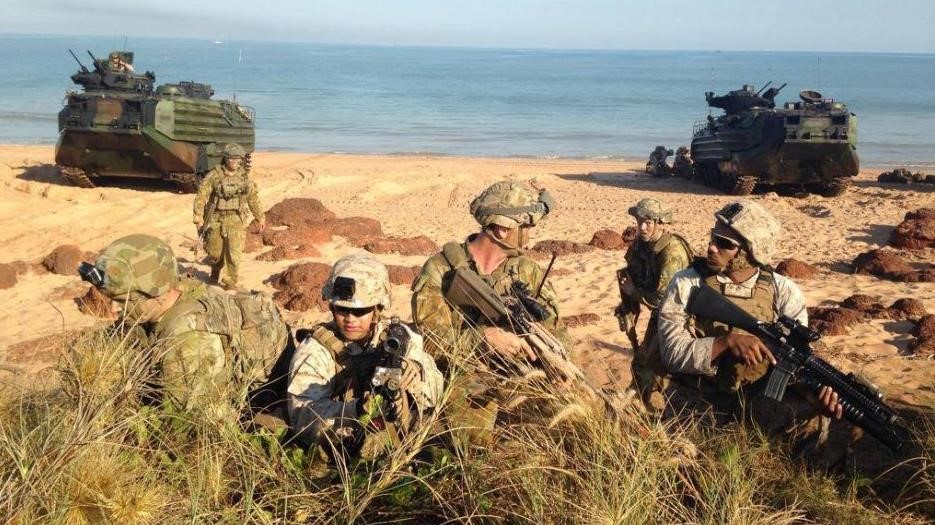
It appears that a self-assessment of the proposed activities has satisfied the Department of Defence that the matter does not require referral in accordance with the processes of the EPBC Act – the routine process which would reasonably be expected to apply for a proposal of this scope and significance.
This sympathetic self-assessment has led to the application of internal departmental processes that appear to mimic those of the relevant environmental laws.
In doing so, the public have been denied the opportunity to contribute to decision making around the scoping of the assessment. This is a significant point of public access to due process that is intended to give greater assurity to all parties that assessment of likely risks and impacts are given due consideration.
If nothing else, this step of early public engagement in the assessment process offers a useful heads-up for all interested stakeholders.
I consider myself to be an interested stakeholder.
I participated in the formal processes around assessment for the previous instance (Talisman Saber 2015). I routinely visit the websites of both the NTEPA and the Federal Department of Environment for their registers of assessments open for public comment.
On the 30th of January, I met with my Federal MP, Mr Luke Gosling OAM, to discuss some concerns I have regarding unmanaged risks stemming from the unprecedented changes of a growing foreign military presence in our town. I specifically described my interest in Talisman Saber 2017, and expressed my hope to participate in the assessment. I followed up our conversation with an email that specifically requested clarity on whether there would be any public environmental assessment – at that point there had been no sign of any.
On the 3rd of February, I met with my local MLA, Ms Lauren Moss, who also happens to be Environment Minister of the Northern Territory. Again, I was keen to describe my concerns: that inevitable impacts of the foreign military build up appear to be virtually unmanaged. I used the Minister’s portfolio as an example, confirming that she had no knowledge of whether the war games would be subject to formal environmental assessment this year.
Again, I followed our meeting with an email, where I impressed upon the Minister that:
‘I am alarmed though to find that at this late stage you are still unsure what role your department will play in assessing the environmental threats of this year’s war games’
noting that:
‘in 2015, the assessment report had already been published by February.’
and reiterating my request for ‘whatever further advice you can provide.’
On February 9th, I met with Shar Malloy, incoming Director of the Environment Centre of the NT. I described my interest in environmental assessment of the joint military exercises, and my frustration at finding no evidence that any public report would be forthcoming, requesting urgent notification of any relevant information.
None of these attempts to engage bore fruit, before March 7th, when I visited the public library and saw the draft PER on public display.
I then wrote to the NT EPA inquiring about their role, and was promptly informed that:
Talisman Sabre 2017 has not been referred to the NT EPA under the Environmental Assessment Act, and therefore the NT EPA does not have a role in the development of the PER. However, the Department of Defence has asked for the NT EPA to make a submission on the PER.
With this detail, I note a number of observations of the deficient process around this years assessment:
Engagement
I’m glad that the draft was on display at the library, but I despair that my experience, as an independently motivated participant, does not bode well for community engagement.
My attempts to find evidence of an imminent assessment prove that key stakeholders and prior participants were not formally appraised of the process.
inappropriate self-assessment
We are assured that the PER is structured in accordance with Schedule 4 of the Environment Protection and Biodiversity Conservation Regulations 2000
In fact, while this report reflects features of relevant federal environmental legislation, the process falls well short.
No rationale or justification is offered for this perverted process
An internal process may well involve a high level of expertise, but nonetheless limits participation of those government agencies whose day to day responsibility and domain expertise is directly relevant to good decision making. The draft reads as though all relevant NT data has come from a desktop review rather than through formal engagement with relevant offices and branches within NT Government. Bypassing the bilateral agreement on environmental protection denies NT authorities their role, and severely curtails public participation and an appropriate level of scrutiny.
The public are left unconvinced that our shared natural environment is being adequately protected given this assessment process bypasses a standard level of scrutiny that other projects routinely receive, let alone the level of assessment that may be reasonably expected of any proposal of this scope, were it coming from any other proponent.
Pertinent detail un-assessed
By avoiding the EPBC referral process, the Department of Defence avoids making any reference to past performance. Boilerplate for the guidelines phase of assessment asks the proponent to provide details of their environmental performance.
By sidestepping this process, we find a draft report that makes no reference to the oil spill experienced on the beach at Lee Point, Casuarina Coastal Reserve, in 2015. Despite this unexpected impact of amphibious landings in the previous instance of joint military exercises across Northern Australia, the appendix for amphibious landing in the Stanage Bay area doesn’t even acknowledge this risk.
In this way, we can see that bypassing due process has allowed significant risk to go un-assessed.
Despite being unable to provide further detail within the timeframe of the public exposure period, I do intend to continue exploring just what role relevant NT authorities have played in this inadequate process. I remain interested in encouraging an appropriate role for Northern Territory representatives and authorities in managing the risks and impacts of the growing foreign military presence.
IPAN STATE ACTIVITIES COMING UP
Brisbane
Just Peace, WILPF, FOE and BWCP are working well together to organise the Global Womens’ March to Ban the Bomb on June 17th.
Perth
June 7th: Mayors for Peace film event in Freo with Josh Wilson, ALP member for Fremantle – another discussion planned for that date
June 16 -18th camping trip to Geraldton’s Kojarena Spy Base, organised by BUMP (Ban Uranium Mining Permanently). This will be our support action for N.Y. ICAN activities.
Melbourne
Women’s March to ban the bomb – June 7
Anti-war rally on 4 July ( in discussion)
